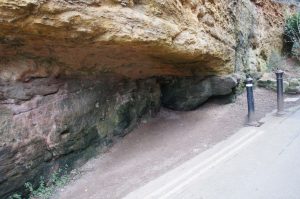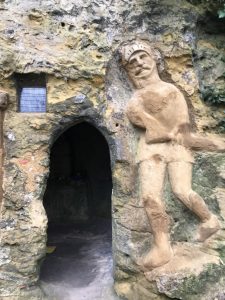What’s on : Activities
Event Information
Geology-themed Walk Round Knaresborough
Friday 14th February 2025
from 10.20am to 3.30pm plus travelling time by train
£7 per person, to include Heritage Centre donation and YPS Admin fee (payable on the day in cash)
The Gorge at Knaresborough was formed in the last glacial advance when the previous course of the River Nidd, originally North and East of the present town, was blocked by an ice-sheet advancing South and West; the Nidd was diverted and cut through the lowest, softest rocks forming the new course. Solid rocks are exposed and exploited along the Gorge: The Permian Cadeby strata (Magnesian Limestones) overlap onto and submerge a surface of irregular relief eroded in the underlying Carboniferous Millstone Grits and shales.
Local resident James McKay, geologist and palaeo-artist, will lead us on a geology-themed walk looking at the Castle and down to Waterside (steep with many steps) and along beside the crags to several old quarries and back to the Market Place via the footpath on top of the crags (about 3.5 miles). There are many places to find lunch and after lunch we will visit inside the Castle, Courthouse and Heritage Centre (which is showing an exhibition on the history of linen in the Knaresborough district).
Trains run from York or Poppleton arriving at Knaresborough 10:07. Meet at Knaresborough Station, or at the Castle by 10:20. Maximum group size 15. YPS organisers: Liam Herringshaw and Paul Thornley
Image credit: Knaresborough Castle viewed from Knaresborough Forest Park ©James McKay
Booking form: Visit to Knaresborough
Member’s report
320 million years of geological history covered in just a few steps. That was the focus of the YPS Geology Group visit to Knaresborough on 14th February, organised by Paul Thornley. The walk leader was James Mackay, a paleo-artist from Knaresborough who specialises in paintings of ancient landscapes and has books to his credit including a recent book about dinosaurs. Liam Herringshaw co-led, describing the geological features of the Nidd Gorge, formed when glacial ice blocked the proto-Nidd to the north and east of Knaresborough forcing it to cut through softer rocks to the south.
A planned visit inside the Castle didn’t happen due to filming for Sky TV. Unfortunately, YPS members weren’t asked to serve as extras. James explained the castle’s history outlining how it was closely associated with Edward II and his favourite Piers Gaveston. The Castle was untouched by the Scots raiders when they burnt the town, the church and the priory in 1318. Soon after, it was given to Queen Philippa of Hainault, the wife of Edward III. In the Civil Wars it was held by the King and partially destroyed afterwards. A local community group has recently bought 100 acres of the former Royal Forest Park across the river.
 We then descended the very steep steps to the gorge, crossing the point where Permian limestone rocks of the Cadeby formation rest unconformably on the Carboniferous millstone grit, crossing a gap of about 60 million years. This feature is repeated further along the walk.
We then descended the very steep steps to the gorge, crossing the point where Permian limestone rocks of the Cadeby formation rest unconformably on the Carboniferous millstone grit, crossing a gap of about 60 million years. This feature is repeated further along the walk.
The Cadeby (Magnesian Limestone) formation was laid down as part of the one-time Zechstein Sea, also known for the vast evaporite deposits found at Boulby mine. At Knaresborough it appears as part of the magnesian limestone deposits also found notably near Tadcaster.
We looked at the Chapel of Our Lady of the Crag, carved from the rock in mediaeval times and specially opened for our party by two lady volunteers. From the roadway we could see across the river to the Dropping Well, where objects are rapidly coated in lime sediment to be metaphorically and quickly ‘turned to stone”. After looking at several quarries and the remains of the Trinitarian St Robert’s Priory, now almost vanished, we walked up a hollow way to look at a former monastic fish pond, Aspin Pond, now home to great crested newts, and back to Knaresborough market place.
sediment to be metaphorically and quickly ‘turned to stone”. After looking at several quarries and the remains of the Trinitarian St Robert’s Priory, now almost vanished, we walked up a hollow way to look at a former monastic fish pond, Aspin Pond, now home to great crested newts, and back to Knaresborough market place.
Here we dispersed for lunch and then divided into two groups to visit the Heritage Centre exhibition about Knaresborough’s linen industry and then the Courthouse Museum, linked to the Castle with an original Tudor court room and displays of the royal residents and the history of the area from prehistoric times to the ever-popular annual bed race.
Those travelling by train were able to examine the faux railway posters which adorn Knaresborough railway station.
It was an excellent visit, an eye-opener for those of us who thought we knew all about Knaresborough. Thanks to Paul, James and Liam for their organisation.
Roger Backhouse (with additional information from Paul Thornley)
Images: Great Unconformity by Roger Backhouse; Chapel of Our Lady of the Crag by Rosemary Anderton

